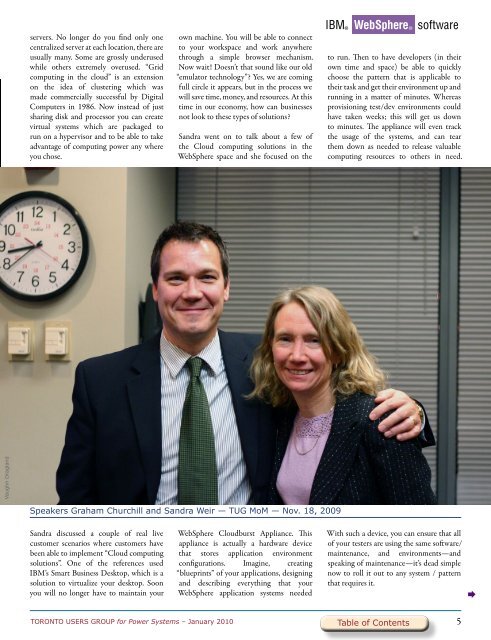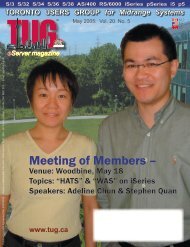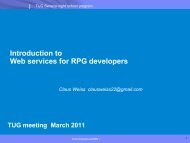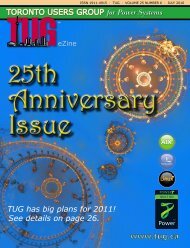Complete Magazine - PDF (5589K) - Toronto Users Group for Power ...
Complete Magazine - PDF (5589K) - Toronto Users Group for Power ...
Complete Magazine - PDF (5589K) - Toronto Users Group for Power ...
Create successful ePaper yourself
Turn your PDF publications into a flip-book with our unique Google optimized e-Paper software.
Vaughn Dragland<br />
servers. No longer do you find only one<br />
centralized server at each location, there are<br />
usually many. Some are grossly underused<br />
while others extremely overused. “Grid<br />
computing in the cloud” is an extension<br />
on the idea of clustering which was<br />
made commercially successful by Digital<br />
Computers in 1986. Now instead of just<br />
sharing disk and processor you can create<br />
virtual systems which are packaged to<br />
run on a hypervisor and to be able to take<br />
advantage of computing power any where<br />
you chose.<br />
Sandra discussed a couple of real live<br />
customer scenarios where customers have<br />
been able to implement “Cloud computing<br />
solutions”. One of the references used<br />
IBM’s Smart Business Desktop, which is a<br />
solution to virtualize your desktop. Soon<br />
you will no longer have to maintain your<br />
TORONTO USERS GROUP <strong>for</strong> <strong>Power</strong> Systems – January 2010<br />
own machine. You will be able to connect<br />
to your workspace and work anywhere<br />
through a simple browser mechanism.<br />
Now wait! Doesn’t that sound like our old<br />
“emulator technology”? Yes, we are coming<br />
full circle it appears, but in the process we<br />
will save time, money, and resources. At this<br />
time in our economy, how can businesses<br />
not look to these types of solutions?<br />
Sandra went on to talk about a few of<br />
the Cloud computing solutions in the<br />
WebSphere space and she focused on the<br />
Speakers Graham Churchill and Sandra Weir — TUG MoM — Nov. 18, 2009<br />
WebSphere Cloudburst Appliance. This<br />
appliance is actually a hardware device<br />
that stores application environment<br />
configurations. Imagine, creating<br />
“blueprints” of your applications, designing<br />
and describing everything that your<br />
WebSphere application systems needed<br />
to run. Then to have developers (in their<br />
own time and space) be able to quickly<br />
choose the pattern that is applicable to<br />
their task and get their environment up and<br />
running in a matter of minutes. Whereas<br />
provisioning test/dev environments could<br />
have taken weeks; this will get us down<br />
to minutes. The appliance will even track<br />
the usage of the systems, and can tear<br />
them down as needed to release valuable<br />
computing resources to others in need.<br />
With such a device, you can ensure that all<br />
of your testers are using the same software/<br />
maintenance, and environments—and<br />
speaking of maintenance—it’s dead simple<br />
now to roll it out to any system / pattern<br />
that requires it.<br />
Table of Contents<br />
5





